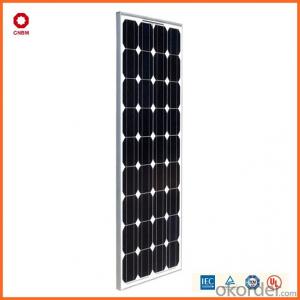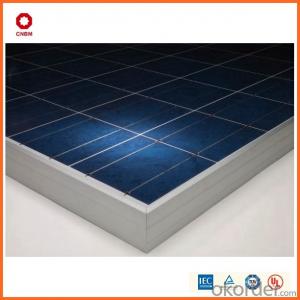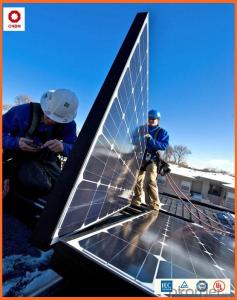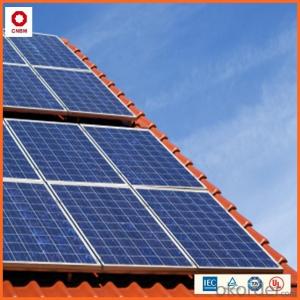75w Small Solar Panels in Stock China Manufacturer
- Loading Port:
- China main port
- Payment Terms:
- TT OR LC
- Min Order Qty:
- 1 watt
- Supply Capability:
- 10000000 watt/month
OKorder Service Pledge
OKorder Financial Service
You Might Also Like
Item specifice
Product Description:
Hot Sale !!! Quality and Safety of Small Poly Solar Panel 5w~150w
1. Rigorous quality control meets the highest international standards.
2. High-transmissivity low-iron tempered glass, strong aluminium frame.
3. Using UV-resistant silicon.
4. IS09001/14001/CE/TUV/UL
Warranties of Small Poly Solar Panel 35~85w
1. 10 years limited product warranty
2. 15 years at 90% of the minimal rated power output
3. 25 years at 80% of the minimal rated power output
Specification
Characteristics of Poly solar panels CNBM (245-320W) | |||||
Max Power Voltage Vmp(V) | 30.3 | 30.8 | 31.1 | 31.4 | 31.85 |
Max Power Current Imp(A) | 7.60 | 7.64 | 7.73 | 7.81 | 7.85 |
Open Circuit Voltage Voc(V) | 36.1 | 36.6 | 37 | 37.3 | 37.68 |
Short Circuit Current Isc(A) | 8.50 | 8.55 | 8.65 | 8.75 | 8.85 |
Max Power Pm(W) | 230W | 235W | 240W | 245W | 250W |
Temperature Coefficient of Cells Poly solar panels CNBM (245-320W) | |
NOCT | 45± 2 |
Temperature Coeffucients of Isc | 0.0492 |
Temperature Coeffucients of Voc | -0.3374 |
Temperature Coeffucients of Voc | -0.4677 |
Mechanical Data of Poly solar panels CNBM (245-320W) | |
Dimension | 1638 × 982 × 40 mm |
Weight | 19.5 kg |
No. of Cells and Connections | 60 (6 ×10) |
Tolerance | 0 ~ + 5 W |
Cell | Monocrystalline Cell 156 × 156 mm |
Packing | 624 Pcs/40ft(H) Container |
Limits of Poly solar panels CNBM (245-320W) | |
Operating Temperature | -40 to +85 |
Storage Temperature | -40 to +85 |
Max System Voltage | 1000VDC(IEC) / 600VDC(UL) |
Features of our products:
• High conversion efficiency mono/poly-crystalline amorphous silicon solar cells
• Modules incorporate high performance bypass diodes to minimize the power drop caused by shading
• High transmittance, low-iron tempered glass
• High performance EVA encapsulant to prevent destroying and water.
• AI frame: without screw, corner connection. 8 holes on the frame can be installed easily
• Good performance of preventing from atrocious weather such as wind and hails
• Certifications: CE IEC TUV VDE UL, Class I
• 10 years 90% power output warranty

Shipping of Small Poly Solar Panel 35~85w
By Sea | Delivery from Shanghai or Ningbo seaport |
By Air | Departure from Shanghai Pudong Airport |
By Express | Post by DHL, EMS, UPS, TNT. |
Features of our products:
• High conversion efficiency mono/poly-crystalline amorphous silicon solar cells
• Modules incorporate high performance bypass diodes to minimize the power drop caused by shading
• High transmittance, low-iron tempered glass
• High performance EVA encapsulant to prevent destroying and water.
• AI frame: without screw, corner connection. 8 holes on the frame can be installed easily
• Good performance of preventing from atrocious weather such as wind and hails
• Certifications: CE IEC TUV VDE UL, Class I
• 10 years 90% power output warranty
As a professional Solar Panel manufacturer and Supplier in China, we have our customers come around the whole world and our specialization has got a worldwide recognition. Meanwhile, with our superior quality, competitive price, prompt and excellent service, As main role in trade section of CNBM Group, CNBM International Corporation supplies products including Monocrystalline Solar Panel, Polycrystalline Solar Panel ( multicrystalline silicon Solar Panel) have received and enjoyed famous reputation in many countries and regions in the world.
- Q:Can solar energy systems be used for air conditioning?
- Yes, solar energy systems can be used for air conditioning. Solar-powered air conditioning systems utilize the sun's energy to generate electricity, which is then used to power the air conditioning unit. This renewable energy source can help reduce electricity bills and minimize the environmental impact associated with traditional air conditioning methods.
- Q:Can solar energy systems be used for powering off-grid eco-retreats?
- Yes, solar energy systems can definitely be used for powering off-grid eco-retreats. Solar panels can harness energy from the sun and convert it into electricity, providing a sustainable and renewable source of power. These systems can be installed on the rooftops or in open spaces of eco-retreats to generate electricity for lighting, heating, cooling, and other electrical needs. Additionally, solar energy systems can be combined with batteries to store excess energy for use during nighttime or cloudy days, ensuring a consistent power supply. By utilizing solar energy, off-grid eco-retreats can reduce their dependence on fossil fuels and minimize their environmental impact while enjoying a reliable and clean energy source.
- Q:What is the average cost of a solar panel system?
- The average cost of a solar panel system can vary depending on several factors such as the size of the system, location, and quality of equipment. However, on average, a residential solar panel system can cost between $15,000 to $25,000, including installation. It's important to note that there may be additional costs for permits, maintenance, and any necessary upgrades.
- Q:What happens to excess electricity generated by a solar energy system?
- Excess electricity generated by a solar energy system can be stored in batteries for later use when the system doesn't produce enough power, or it can be fed back into the grid through a process called net metering, where it is credited to the owner's account to offset future electricity consumption.
- Q:Can a solar energy system be used in areas with high humidity?
- Yes, a solar energy system can be used in areas with high humidity. While it is true that high humidity can affect the performance of a solar energy system to some extent, modern solar panels are designed to withstand various weather conditions, including high humidity. The efficiency of solar panels may decrease slightly in high humidity due to the moisture in the air, but it is not a significant factor that would render solar energy systems ineffective. Additionally, proper maintenance and cleaning of the panels can help mitigate any potential issues caused by humidity. Overall, solar energy systems can still be effectively utilized in areas with high humidity.
- Q:How do solar energy systems impact local wildlife?
- Solar energy systems can have both positive and negative impacts on local wildlife. On one hand, these systems do not produce air or water pollution, reducing habitat degradation and improving overall air quality. Additionally, solar panels can provide shade and shelter for certain species. However, the installation of solar farms can lead to habitat loss and fragmentation, affecting the natural movement and breeding patterns of some animals. It is essential to carefully plan and design solar energy systems to minimize these negative effects and protect local wildlife.
- Q:What is the difference between a solar thermal system and a photovoltaic system?
- A solar thermal system and a photovoltaic system are both forms of solar energy systems, but they function differently and have distinct purposes. A solar thermal system is primarily used for heating purposes. It harnesses the sun's energy to heat water or air directly. This is achieved by using solar collectors, which absorb sunlight and convert it into heat. The heated water or air is then used for various applications like space heating, water heating, or even for powering turbines to generate electricity. Solar thermal systems are commonly used in residential, commercial, and industrial settings to provide hot water or heating solutions. On the other hand, a photovoltaic system, commonly known as solar panels, is designed to generate electricity from sunlight. It utilizes photovoltaic cells, typically made of silicon, to directly convert sunlight into electricity through the photovoltaic effect. These cells are interconnected in solar panels, and multiple panels can be combined to form an entire photovoltaic system. The electricity generated by a photovoltaic system can be used to power various electrical devices, appliances, or even feed into the grid to offset energy consumption. In summary, the main difference between a solar thermal system and a photovoltaic system lies in their respective purposes. Solar thermal systems primarily focus on heating applications, utilizing the sun's energy to heat water or air directly. On the other hand, photovoltaic systems are designed to produce electricity by converting sunlight into electrical energy using solar panels.
- Q:Can solar energy systems be used for powering off-grid telecommunications networks?
- Yes, solar energy systems can be used effectively for powering off-grid telecommunications networks. Solar panels can generate electricity from sunlight, which can then be stored in batteries for use during periods of low or no sunlight. This renewable energy source provides a reliable and sustainable power solution for off-grid telecommunications networks, ensuring continuous operation even in remote locations without access to traditional power grids. Additionally, solar energy systems are cost-effective and environmentally friendly, making them a preferred choice for powering off-grid telecommunications networks.
- Q:Are solar energy systems suitable for agricultural applications?
- Yes, solar energy systems are suitable for agricultural applications. They provide a sustainable and reliable source of power for various agricultural operations such as irrigation, livestock management, and powering machinery. Solar energy systems can help reduce dependence on fossil fuels, lower operating costs, and contribute to a more environmentally friendly farming practice.
- Q:How much space do solar panels take up on a roof?
- The amount of space solar panels take up on a roof depends on several factors such as the size and type of panels used, as well as the specific layout and orientation of the roof. On average, solar panels typically require around 10-12 square feet of space per kilowatt of power capacity.
1. Manufacturer Overview |
|
|---|---|
| Location | |
| Year Established | |
| Annual Output Value | |
| Main Markets | |
| Company Certifications | |
2. Manufacturer Certificates |
|
|---|---|
| a) Certification Name | |
| Range | |
| Reference | |
| Validity Period | |
3. Manufacturer Capability |
|
|---|---|
| a)Trade Capacity | |
| Nearest Port | |
| Export Percentage | |
| No.of Employees in Trade Department | |
| Language Spoken: | |
| b)Factory Information | |
| Factory Size: | |
| No. of Production Lines | |
| Contract Manufacturing | |
| Product Price Range | |
Send your message to us
75w Small Solar Panels in Stock China Manufacturer
- Loading Port:
- China main port
- Payment Terms:
- TT OR LC
- Min Order Qty:
- 1 watt
- Supply Capability:
- 10000000 watt/month
OKorder Service Pledge
OKorder Financial Service
Similar products
New products
Hot products
Hot Searches
Related keywords






























